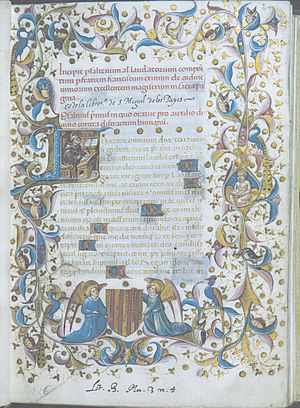Psalterium alias Laudatorium facts for kids
The Psalterium alias Laudatorium is a special book of prayers. A writer named Francesc Eiximenis wrote it in Latin between 1404 and 1408. He was living in Valencia, Spain, at the time. This book is a collection of many prayers. Eiximenis gave it to Pope Benedict XIII, who was the Pope in Avignon.
Contents
What's Inside the Book?
This book has 344 prayers. They are grouped into three main parts. Each part helps people think deeply about different things:
- De laude creatoris: This part is about praising God, the Creator.
- De vita et excellentia redemptoris: This section focuses on the life and greatness of Jesus.
- De vita et ordinatione hominis viatoris: This part talks about how people should live their lives in the world.
A scholar named Albert Hauf said that this book and another one by Eiximenis, called Vida de Jesucrist, are like two parts of the same big project. They share similar ideas, but they are written in different styles.
How the Book Started
Francesc Eiximenis worked on this beautiful collection of prayers between 1404 and 1408. The first prayers he wrote were for Berenguer de Ribalta. Berenguer had just become a bishop in Tarazona in 1404.
Later, Eiximenis finished the whole collection. He then gave it to Pero de Luna, who was the Pope in Avignon, Benedict XIII.
Pope Benedict XIII might have been interested in the book as early as 1405. But it's likely that Eiximenis gave the finished book to the Pope in November 1408. This happened when Eiximenis went to a big meeting called the Council of Perpignan. Some people think that the Pope liked the book so much that it helped Eiximenis get two important church jobs. He became a patriarch (a very high-ranking bishop) in Jerusalem. He also became a temporary bishop for the diocese of Elna.
Other Versions of the Book
A part of the book, with 100 prayers, was translated into Catalan in 1416. A person named Guillem Fontana did this translation. This Catalan version was later printed in Gerona on March 20, 1495.
Where to Find Digital Copies
You can find digital copies of this book in different forms:
Old Handwritten Books
- [1] You can see a digital copy of an old handwritten version (manuscript 726) from the University of Valencia. This copy was made in 1442-3 by Pere Bonora and Lleonard Crespí (who drew the small pictures) and Domènec Sala (who bound the book). It used to belong to the libraries of Alfonso the Magnanimous and the Duke of Calabria.
Early Printed Books
- [2] This link shows a digital copy of the early printed version (called an incunabulum) of Guillem Fontana's Catalan translation. It was printed in Gerona in 1495.
Newer Editions
- [3] You can find a modern edition of the Psalterium alias Laudatorium here. It's part of a collection of all of Eiximenis' works. This specific edition was published in Toronto in 1988.
All of Eiximenis' Works
- Francesc Eiximenis' complete works (available in Catalan and Latin).
See also
 In Spanish: Psalterium alias Laudatorium para niños
In Spanish: Psalterium alias Laudatorium para niños


